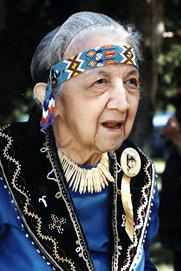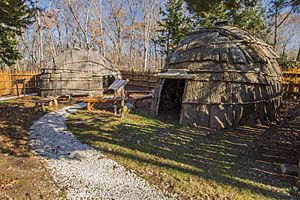Gladys Tantaquidgeon facts for kids
Quick facts for kids
Dr.
Gladys Tantaquidgeon
|
|
|---|---|
 |
|
| Born |
Gladys Iola Tantaquidgeon
June 15, 1899 |
| Died | November 1, 2005 (aged 106) Mohegan Hill, Uncasville, Connecticut USA
|
| Alma mater | University of Pennsylvania, School of Anthropology |
| Occupation | Native American anthropologist, medicine woman, social worker, author |
| Employer | Bureau of Indian Affairs, Federal Indian Arts and Crafts Board |
| Known for | Preserving customary Mohegan spirituality, Native ceremonies and art forms |
Gladys Iola Tantaquidgeon (June 15, 1899 – November 1, 2005) was an important Mohegan leader. She was a medicine woman, anthropologist, and author from Connecticut. She also served on her tribal council and was an elder. She worked hard to preserve her tribe's traditions.
From a young age, Mohegan women elders chose Gladys for special training. She learned about traditional healing and culture. She also studied anthropology at the University of Pennsylvania.
Gladys worked for the U.S. government, helping Native American tribes. In 1931, she helped create the Tantaquidgeon Indian Museum. This museum is the oldest one owned and run by Native Americans. She also wrote books about Native American medicine. Her work helped the Mohegan tribe gain official federal recognition from the U.S. government in 1994. She was honored in the Connecticut Women's Hall of Fame that same year.
Contents
About Gladys Tantaquidgeon
Early Life and Learning
Gladys Tantaquidgeon was born on June 15, 1899. She was the third of seven children. Her parents, John and Harriet Tantaquidgeon, were Mohegan people. They lived on Mohegan Hill in Uncasville, Connecticut. Gladys was a direct descendant of Chief Uncas, a famous Mohegan leader from long ago.
The Mohegan tribe is part of the Algonkian culture. They speak one of the many Algonquian languages. As a child, Gladys learned traditional ways from nanus, who were respected women elders. By age five, these elders chose her to be taught Mohegan culture.
One of her teachers was Fidelia Fielding (1827–1908). From Fielding, she learned about the makiawisug, who protect healing plants. Another teacher was her aunt, Nanu Emma Fielding Baker (1828-1916). Emma Baker was later named the Mohegan Tribal Medicine Woman. She was also inducted into the Connecticut Women's Hall of Fame. Gladys began studying with her aunt in 1904. She focused on traditional herbal medicine and also attended local schools.
In 1919, at age 20, Tantaquidgeon went to the University of Pennsylvania. She studied anthropology there. A professor named Frank Speck had met Gladys when she was a child. He invited her to study with him at Penn. He helped her find a place to live and enrolled her in classes. She also helped him with his research. This helped her learn more about Native American cultures.
Tantaquidgeon later did research with the Lenape and other eastern Algonquian tribes. She learned more about traditional pharmacopeia, which is the study of medicinal plants. She researched how different East Coast tribes used herbal medicine.
Working for Native American Culture
From 1934 to 1947, Gladys Tantaquidgeon worked for the U.S. Bureau of Indian Affairs. This was during a time called the Indian New Deal. She was hired in 1934 to help Native Americans with social services. Her first assignment was at the Yankton Indian Reservation in South Dakota.
In 1938, Tantaquidgeon moved to the Indian Arts and Crafts Board. She worked as a "Native Arts Specialist." She traveled to places like the Dakotas, Montana, and Wyoming. There, she helped Native American artists keep their traditional skills and arts alive.
She also helped them create groups to sell and manage their art. She found ways for tribes to bring back their cultural practices. According to Mohegan Tribal Historian Melissa Fawcett, Gladys helped bring back customs that had been banned. These included the Ghost Dance and the Sun Dance. Part of her job was to encourage the return of these old traditions.
The Tantaquidgeon Indian Museum
In 1931, Gladys Tantaquidgeon worked with her brother Harry and her father John. Together, they founded the Tantaquidgeon Indian Museum. This museum is the oldest one owned and run by Native Americans.
After leaving government service in 1947, Tantaquidgeon returned home. She worked full-time at the museum for 50 years, until 1998.
Preserving Mohegan History
In the late 1940s, Tantaquidgeon worked as a librarian. She helped minority women at the Niantic Women's Prison. In the 1970s and 1980s, she was on the Mohegan Tribal Council. She encouraged the tribe to preserve and revive their customs and language. Gladys also served as a special guardian of Mohegan Hill.
Tantaquidgeon wrote several books about traditional herbal medicine. Her most famous book is A Study of Delaware Indian Medicine Practices and Folk Beliefs (1942). It was reprinted several times. In 1992, she was chosen as the Tribal Medicine Woman of the Mohegan.
She kept many important records and letters from tribal members. These documents were stored in boxes under her bed. They became very important evidence for the tribe's case for federal recognition. The tribe proved they had a continuous community. They were officially recognized by the U.S. government in 1994. This was part of an agreement about their land claims.
Dr. Gladys Tantaquidgeon was the great-aunt of Melissa Tantaquidgeon Zobel. Melissa is an author and the current Mohegan Medicine Woman.
Legacy and Honors
Gladys Tantaquidgeon received many awards and honors:
- She was given the 'Tiffany Jewel' by the University of Connecticut. This was for being an "outstanding role model."
- She received the Connecticut Education Association's Friend of Education Award.
- In 1996, she received the National Organization for Women’s Harriet Tubman Award. This was for her work in social justice.
- She received honorary doctorates from the University of Connecticut (1987) and Yale University (1994).
- In 1994, she was inducted into the Connecticut Women's Hall of Fame.
- Her 100th birthday, June 15, 1999, was named 'Gladys Tantaquidgeon Day'. This was declared by Governor John G. Rowland of Connecticut. It was also noted in the U.S. Congress by Hon. Sam Gejdenson.
- A carving of her likeness was made from sacred basswood. It is now on the Mohegan Reservation.


